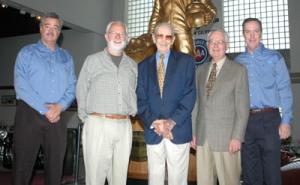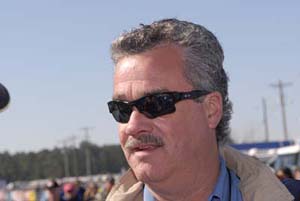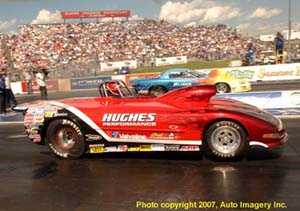SETTING THE RECORD STRAIGHT - THE FACTS AND FICTIONS REGARDING THE HDP ACQUISITION
Within hours of the public announcement on May 30th of the proposed acquisition of the NHRA’s professional racing assets by the HD Partners Acquisition Corp. (HDP), the racing press and online message boards/forums went into swooning, virtual hyperventilation. Banner headlines pronounced “NHRA—Sold!” or, “NHRA Under New Ownership.” No doubt, the choice of verbage was deliberate so as to attract attention through shock, but these grossly incorrect opening media salvos set the tone for the misinformation feeding frenzy that followed on the message boards: A smorgasborg of stunned uncertainty and confusion as well as some hysterical—sometimes hysterically funny—tirades, rants, ramblings and dire warnings of impending doom.
Research professional Len Romanick provides a no-nonsense analysis of the state of the HDP acquisition of NHRA

Within hours of the public announcement on May 30th of the proposed acquisition of the NHRA’s professional racing assets by the HD Partners Acquisition Corp. (HDP), the racing press and online message boards/forums went into swooning, virtual hyperventilation. Banner headlines pronounced “NHRA—Sold!” or, “NHRA Under New Ownership.” No doubt, the choice of verbage was deliberate so as to attract attention through shock, but these grossly incorrect opening media salvos set the tone for the misinformation feeding frenzy that followed on the message boards: A smorgasborg of stunned uncertainty and confusion as well as some hysterical—sometimes hysterically funny—tirades, rants, ramblings and dire warnings of impending doom.
Ready or not, and not surprisingly, the first drag racing e-zine article posted the very next day, initiating a steady flow of editorial flotsam that often read more like a mash-up of Michael Moore and the National Enquirer, rather than competent reporting or astute and well-reasoned opinion. The arm-chair “analysis” and predictions that followed were based on a Swiss-cheese selection of misunderstood and misinterpreted press releases, financial news, and regulatory filings, with the various pundits displaying a profound lack of awareness, let alone knowledge, of the underlying fundamental legal, regulatory, financial, accounting, and due-diligence principles that define this complex acquisition process. Rather than doing their readership a service by first recognizing and educating themselves on the massive gaps in their own knowledge, these savants boldly went where they should not have gone, offering trite conclusions based on regurgitated material they obviously did not understand, and could not explain; and opinions displaying astounding ignorance, which in turn fostered, fed, and validated a puerile cornucopia of misinformation, bizarre opinions, useless speculation, and fallacious hearsay in the online forums, and, I’m sure, countless pit conversations.
Ready or not, and not surprisingly, the first drag racing e-zine article posted the very next day, initiating a steady flow of editorial flotsam that often read more like a mash-up of Michael Moore and the National Enquirer, rather than competent reporting or astute and well-reasoned opinion.
 It is now a bit more than six months after the proposed
acquisition announcement. If you have perused the various online forums in the
past few weeks, you are aware they are unusually quiet, probably because,
publicly, nothing much appears to be happening concerning the acquisition
process, so there is little content being produced by the e-zines which usually
stoke the boards. The few furtive attempts to deliberately create uncertainty
and controversy have been met with a public yawn. Most of the hysteria and
blather has calmed down substantially. Substantially, but not completely (as
evidenced by a recent thread about Bruton Smith and institutional trading in HDP
securities).
It is now a bit more than six months after the proposed
acquisition announcement. If you have perused the various online forums in the
past few weeks, you are aware they are unusually quiet, probably because,
publicly, nothing much appears to be happening concerning the acquisition
process, so there is little content being produced by the e-zines which usually
stoke the boards. The few furtive attempts to deliberately create uncertainty
and controversy have been met with a public yawn. Most of the hysteria and
blather has calmed down substantially. Substantially, but not completely (as
evidenced by a recent thread about Bruton Smith and institutional trading in HDP
securities).
I recently spent an evening catching up on what has been
written in the motor sports and traditional press, the e-zines, and postings on
various online forums. It is clear that the relatively fresh postings I saw
related to the acquisition continue to be based (and I’m being kind here) on
limited and misunderstood information, maintaining the stream of unfounded and
useless speculation of what has, is, and is likely to happen, pre- and
post-consummation of this deal—assuming it does consummate.
A few days later, while recuperating from yet another methodical review of yet another revision of the preliminary proxy statement, and lamenting the state of informational affairs concerning this entire subject, I was pleasantly surprised by an invitation from Torco’s CompetitionPlus.com to write on the present and future state of the acquisition process. Serendipity.
Thankfully, the editorial management at CompetitionPlus.com recognizes that this massive topic is not well understood and so, has not been well explained. They also recognize that in order to write about the present state of affairs, let alone what the future holds, there needs to be a better understanding of what has occurred to date, and why. So, while racing news is slow in the off-season and we wait for the next step in the acquisition process to occur, they agree that now would be a good time to review the acquisition process, correct some of the misinformation, and dispel some of the speculation swirling around this topic.
a d v e r t i s e m e n t
Click to visit our sponsor's website
 We will start in the present, if for no other reason than to
temporarily disregard what has been said about this process and factually
establish where it stands, and what, despite surface appearances that nothing is
going on, is actually happening out of public view. Future installments will
jump back to the day of the announcement and begin a long- overdue process of
correcting misconceptions, misinformation, incorrect analysis, and urban legends
that have developed from “facts” that were never so. If events don’t overtake us
in the meantime, we may be able to delve into how the process should continue in
the future.
We will start in the present, if for no other reason than to
temporarily disregard what has been said about this process and factually
establish where it stands, and what, despite surface appearances that nothing is
going on, is actually happening out of public view. Future installments will
jump back to the day of the announcement and begin a long- overdue process of
correcting misconceptions, misinformation, incorrect analysis, and urban legends
that have developed from “facts” that were never so. If events don’t overtake us
in the meantime, we may be able to delve into how the process should continue in
the future.
I am using the word “we” in the sense that this series is
intended to be a collaborative process. There are layers of complexity involved
in this acquisition process that cross many professional disciplines. While I am
personally comfortable digging to great depths into this kind of research, I
realize boundaries need to be set so that readers are not overwhelmed by detail
that, in the words of Jon Asher, “make my eyes glaze over.” It is unavoidable
that some of the discussion may require the reader to invest more of themselves
than just passive reading for entertainment. There are fundamental principles
involved that must be understood and “stick” if what will follow in the
development of a particular topic will also be understood. Invoking and
paraphrasing the wisdom of Einstein, my goal is to explain things as simply as
possible, but no simpler. With that admonition in mind, here is a potential
sampling of some essential topics:
• Understanding what the NHRA is and is not. This is a huge topic in itself. The lack of knowledge concerning the fundamentals of the NHRA’s corporate existence are, by far, the single biggest impediment to understanding NHRA operations and, without a doubt, the origin of most of the misconceptions and misinformation perpetrated in articles and online forums.
• What is HD Partners Acquisition Corporation? What little I have seen written specifically about HDP has been thin and not very informative. We know about their involvement in DirectTV. That’s all well and good, and relevant to the acquisition, but what we need to understand is what kind of entity this corporation is, it’s purpose for being, it’s operations to date, as well as why and how its activities are regulated.
• What is the procedural process, and the legal, regulatory, and financial nuts-and-bolts of this proposed business combination?
• There was, and continues to be, much consternation about the valuation of the deal. Is it undervalued? This is a complex topic that involves many issues, some quite subjective, that requires addressing details of the topics in the first three bullet points above.
• Is this a “sure thing,” a “done deal?”
Please feel free to let CompetitionPlus.com know what is
important to you about this acquisition, and what you feel has not been
adequately addressed to date. Your interests, concerns, and questions will help
prioritize and direct how this series will proceed. And yes, I will be
monitoring the boards when I have time.
a d v e r t i s e m e n t
Click to visit our sponsor's website
Let’s get started…
What’s Going On Now In The Acquisition Process?
 Here’s the short answer: The proxy solicitation and statement,
required by the Securities and Exchange Commission (SEC) to be distributed by
HDP to investors prior to the special meeting that will decide the fate of this
acquisition, is still in the preliminary form undergoing the review and revision
cycle with the SEC.
Here’s the short answer: The proxy solicitation and statement,
required by the Securities and Exchange Commission (SEC) to be distributed by
HDP to investors prior to the special meeting that will decide the fate of this
acquisition, is still in the preliminary form undergoing the review and revision
cycle with the SEC.
Here’s the longer background:
Publicly, this review process appears to have started on July 17, 2007, the filing date of a preliminary proxy statement by HDP with the SEC. But the process began much earlier with the preparation of that initial document. SEC proxy rules promulgate required content, a sliver of which includes such items as audited financial statements for the parties involved, pro forma financial statements that give a financial portrayal of the business combination, detailed discussions of the pros and cons of the proposed business combination, background on negotiations, discussion of fairness opinions, as well as administrative details concerning the agenda for the impending special meeting of the stockholders. This initial preliminary statement was 350 pages.
Upon receipt by the SEC, a staff review process begins during which they pore over the document, scrutinizing it for compliance with SEC content requirements, with particular scrutiny paid to the terms of the proposed business combination. Questions and comments were compiled culminating in a letter sent back to HDP with said comments along with “suggestions” and requests for additional clarifying information. I am being mildly speculative, as this review process is not public, but after slogging through three revisions, changes appear to have included reorganizing or reformatting sections to enhance clarity, breaking out certain information into its own section or as separate tables, and additional financial information or narrative discussion added to expand on certain topics.
HDP, in collaboration with its contracted financial and legal advisors—specialists in this task—review and address the comments, suggestions, and requests for further information. The statement is rewritten accordingly, and submitted for another review round.
Surprisingly, the bulk of the actual rewriting, according to a conversation on December 7th with Robert Meyers, Chief Financial Officer/Treasurer/Director of HDP, is done in-house by the HD Partners themselves, rather than the underwriters or advisors. It is an activity, he says, that takes up the bulk of their working time. "Our team has a good mix of people. We have finance people and we've got two people with a legal background. We've been trying to do a lot of this ourselves as a way to minimize our expenses. So that's been the push at this point in time.”
What started as “a large number” of revision comments is “now down to a small number,” according to Meyers. This progression would be expected after each round of revisions. As of this writing, there have been three completed review-and-revision cycles, with the fourth rewrite currently undergoing SEC review. The first round took 56 days, the second 29 days, and the third another 29 days. The fourth is presently at 32 days.
Apparently, there must have been quite a large number of SEC comments and requests to be reconciled given that the third revision weighed in at a hefty 578 pages. For those not paying attention, that’s 228 pages, or 65% larger, than the original. There is no way of knowing when the process will finally be completed: It could become definitive today, tomorrow, or it could take weeks, or even months (although HDP does not, nor do I, anticipate such a long delay).
But, unless the latest revision passes SEC muster very soon, expect the review process to be impacted by the holiday season. It could also be delayed if there is a shutdown of the federal government due to ongoing wrangling over the continuing budget resolution, the latest set to expire on December 21st. Obviously, either of these scenarios would also further delay the special shareholder meeting.
a d v e r t i s e m e n t
Click to visit our sponsor's website
 Even if the proxy statement becomes
definitive by the time you read this, the special meeting is not immediately
imminent. According to Meyers, this notification process would take, at bare
minimum, 20 days, but a month would be a more likely. Why? The meeting date
needs to be arranged (the time and location are already publicized), the
definitive proxy statement needs to be printed and mailed to investors,
investors allowed sufficient time to review the contents, and sufficient time
allotted to receive and tabulate votes being cast by proxy. SEC and American
Stock Exchange (AMEX) rules apply. The SEC prefers a 30 day window.
Even if the proxy statement becomes
definitive by the time you read this, the special meeting is not immediately
imminent. According to Meyers, this notification process would take, at bare
minimum, 20 days, but a month would be a more likely. Why? The meeting date
needs to be arranged (the time and location are already publicized), the
definitive proxy statement needs to be printed and mailed to investors,
investors allowed sufficient time to review the contents, and sufficient time
allotted to receive and tabulate votes being cast by proxy. SEC and American
Stock Exchange (AMEX) rules apply. The SEC prefers a 30 day window.
The SEC approved rules in 2005 that allow for proxy solicitation via the Internet (effective July 1, 2007). However, these “e-proxies” rules do not apply to solicitations concerning business combination transactions so this process will done by mail.
Even after being printed and mailed, the definitive proxy statement could be supplemented before the special meeting.
But, unless the latest revision passes SEC muster very soon, expect the review process to be impacted by the holiday season. It could also be delayed if there is a shutdown of the federal government due to ongoing wrangling over the continuing budget resolution, the latest set to expire on December 21st. Obviously, either of these scenarios would also further delay the special shareholder meeting.
Although HDP has said repeatedly in their investor
presentations that they anticipated closing the deal during this fourth quarter,
it is not going to happen (A successful shareholder meeting is not the
closing of the deal). Meyers explains, “The normal administrative review process
is simply taking longer than expected.” Is this significant? In a word: No.
Closing the deal before the end of year was simply a goal, not a drop-dead
benchmark. From HDP’s perspective, there is no material effect on the
acquisition process or corporate operations, or any other significant
consequence. Time will tell if the investors—in particular, the institutional
investors—agree.
One final note on this topic: The mission of the SEC is “to protect investors, maintain fair, orderly, and efficient markets, and facilitate capital formation;” oversee and regulate participants in the securities markets; enforce securities laws; and—specific to this particular discussion—“promoting the disclosure of important market-related information, maintaining fair dealing, and protecting against fraud.” The SEC is not approving or disapproving of this potential transaction. The SEC, or any other government agency, is not in the business of endorsing transactions.
| {loadposition feedback} |







































